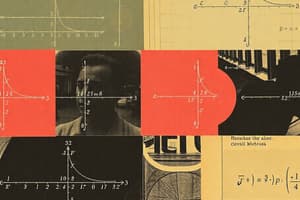Podcast
Questions and Answers
What is a linear equation?
What is a linear equation?
- Any equation that cannot be solved
- An equation involving only one variable
- An equation that graphs as a parabola
- An equation in the form: $a_1x_1+a_2x_2+...+a_nx_n=b$ (correct)
What is a system of linear equations?
What is a system of linear equations?
A collection of linear equations that use the same set of variables.
What is a solution to a linear system?
What is a solution to a linear system?
An ordered n-tuple of real numbers that makes every equation true.
What does solving a linear system mean?
What does solving a linear system mean?
Two linear systems are equivalent if they have the same solution set.
Two linear systems are equivalent if they have the same solution set.
What is the result of solving a two-variable system?
What is the result of solving a two-variable system?
A matrix is defined as:
A matrix is defined as:
What is the Gauss elimination method?
What is the Gauss elimination method?
Match the following terms with their definitions:
Match the following terms with their definitions:
What is a linear system's fundamental question?
What is a linear system's fundamental question?
What is a column vector?
What is a column vector?
What does it mean if a system is homogeneous?
What does it mean if a system is homogeneous?
The homogeneous system is always consistent.
The homogeneous system is always consistent.
X=0 is the ______ solution.
X=0 is the ______ solution.
Describe the condition for a linear system to have a nontrivial solution.
Describe the condition for a linear system to have a nontrivial solution.
V1...vp are linearly independent if there is a nontrivial linear relation between them.
V1...vp are linearly independent if there is a nontrivial linear relation between them.
What characterizes a linear transformation T?
What characterizes a linear transformation T?
If you have more vectors than the number of entries in each of them, they are independent.
If you have more vectors than the number of entries in each of them, they are independent.
What is a transformation T:R^n -> R^m called if it respects vector addition and scalar multiplication?
What is a transformation T:R^n -> R^m called if it respects vector addition and scalar multiplication?
Flashcards are hidden until you start studying
Study Notes
Linear Equations
- A linear equation can be expressed in the form: ( a_1x_1 + a_2x_2 + ... + a_nx_n = b ), where ( a_1, a_2, ..., a_n ) are real numbers.
Systems of Linear Equations
- A linear system is a collection of linear equations that share the same variables.
- A solution to a linear system is an ordered n-tuple of real numbers that satisfies each equation in the system.
Solving Linear Systems
- Finding the solution set of a linear system involves determining all possible solutions.
- Two linear systems are equivalent if they share the same solution set.
Intersection of Lines
- Solving a two-variable system equates to finding the intersection point of two lines.
- A linear system can have no solutions, exactly one solution, or infinitely many solutions.
Matrices
- A matrix is a rectangular arrangement of numbers organized into rows and columns.
- Elementary row operations include row replacement, row interchange, and row scaling.
Gauss Elimination and Row Operations
- The Gauss elimination method simplifies systems by keeping one variable and eliminating it from others, progressing through equations systematically.
- Row equivalent matrices can be transformed into one another via a series of row operations.
Echelon Forms
- A matrix is in Echelon form if all nonzero rows are above rows of zeros and if leading entries move rightward down rows.
- A matrix is in Reduced Echelon form (rref) if it fulfills all criteria of Echelon form plus additional conditions on leading entries.
Consistency and Solutions
- A linear system is consistent if the last column of its augmented matrix does not form a pivot column.
- A consistent linear system has a unique solution when free variables are absent.
Matrix Operations and Vector Spaces
- A column vector is a matrix with a single column.
- ( \mathbb{R}^n ) represents all vectors in n dimensions with real coefficients.
Linear Combinations and Spanning
- The span of vectors ( v_1, ..., v_p ) is the set of all possible linear combinations.
- A vector equation and its corresponding augmented matrix are equivalent if the resulting system is consistent.
Homogeneous Systems
- A system is homogeneous if ( b = 0 ) and always has the trivial solution ( x = 0 ).
- Nontrivial solutions exist in a homogeneous system if there are infinite solutions or free variables present.
Linear Dependence and Independence
- Vectors ( v_1, ..., v_p ) are linearly dependent if a nontrivial linear combination equates to zero.
- Linear independence occurs when the only solution to the equation involving the vectors is the trivial solution.
Transformations
- A transformation ( T:\mathbb{R}^n \rightarrow \mathbb{R}^m ) is linear if it satisfies vector addition and scalar multiplication properties.
- The augmented matrix transformation is a linear transformation.
Onto and One-to-One Mappings
- A transformation is onto if every possible output in ( \mathbb{R}^m ) can be achieved, meaning ( Ax = b ) is consistent.
- A transformation is one-to-one if the corresponding homogeneous equation has only the trivial solution and ensures no free variables exist.
Studying That Suits You
Use AI to generate personalized quizzes and flashcards to suit your learning preferences.




